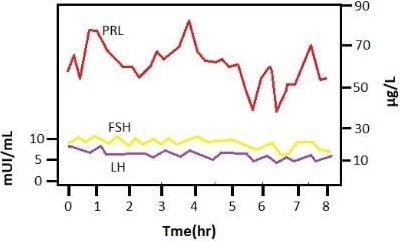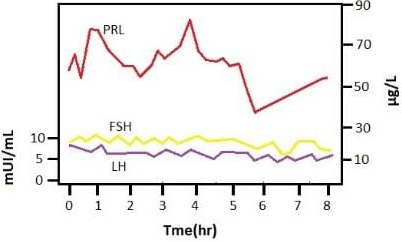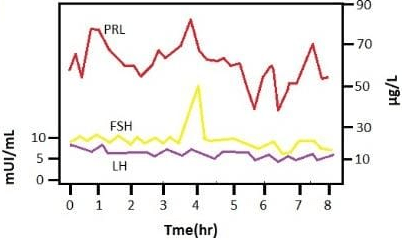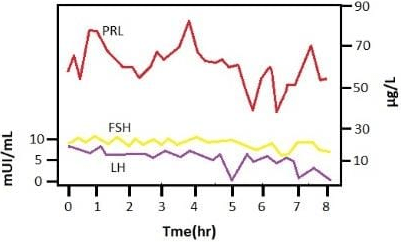This set of Molecular Endocrinology Multiple Choice Questions & Answers (MCQs) focuses on “Physiology and Disorders of Pituitary Hormone Axes”.
1. Which among the following cells comprise 15% to 25% of functioning anterior pituitary cells?
a) Lactotroph Cells
b) Sertoli Cells
c) Leydig Cells
d) Paracrine cells
View Answer
Explanation: Lactotroph cells constitute 15 percent to 25 percent of anterior pituitary cells that function. Their absolute number does not change with age, but during pregnancy and lactation, lactotroph hyperplasia occurs and resolves within several months of delivery.
2. The human PRL gene is located on which among the following chromosome?
a) Chromosome 7
b) Chromosome 6
c) Chromosome 11
d) Chromosome 21
View Answer
Explanation: The human gene, PRL, is located on chromosome 6. Apparently, this originated from a single common ancestral gene giving rise to relatively homologous proteins similar to PRL, GH, and placental lactogen.
3. Which among the following secretion can inhibit PRL hormone in the blood?
a) Epinephrine
b) Acetylcholine
c) Dopamine
d) Pepsin
View Answer
Explanation: The secretion of PRL is under dopamine inhibitory regulation. The tuberoinfundibular cells and the hypothalamic tuber hypophysial dopaminergic system mainly generate this. Dopamine is a neurotransmitter that plays several important roles in the brain and body.
4. Majority of PRL producing cells arise from postmitotic somatotrophs.
a) True
b) False
View Answer
Explanation: Many lactotrophs are removed by the ablation of somatotrophs by GH-diphtheria toxin expression and when GH-thymidine kinase fusion genes are introduced into the germline of transgenic mice. This indicated that the bulk of PRL producing cells are derived from postmitotic somatotrophs.
5. PRL participates in negative feedback to control its release.
a) True
b) False
View Answer
Explanation: To regulate its release, PRL participates in negative feedback. Dopamine released in the tubero-infundibular dopamine neurons of the hypothalamus inhibits PRL secretion from the anterior pituitary gland. This is accomplished by increasing the activity of tyrosine hydroxylase in tuberoinfundibular neurons.
6. In which among the following receptors does dopamine bind on pituitary lactotrophs in order to inhibit that?
a) Type 3 dopamine (D3) receptor
b) Type 2 dopamine (D2) receptor
c) Type 7 dopamine (D7) receptor
d) Type 11 dopamine (D11) receptor
View Answer
Explanation: Dopamine, through the hypothalamic pituitary portal system, enters the lactotrophs. And this, by binding to type 2 dopamine (D2) receptors on pituitary lactotrophs, inhibits PRL secretion.
7. Which among the following is an example of a substance that act as PRL-releasing factor?
a) Basic FGF
b) TFS
c) Leptin
d) Adiponectin
View Answer
Explanation: Many compounds function as PRL-releasing factors. PRL synthesis and secretion is caused by basic FGF and epidermal growth factor. Dopamine stimulates multiple interacting intracellular signalling pathways and suppresses PRL gene expression and lactotroph proliferation, in addition to inhibiting PRL release by regulating calcium fluxes.
8. Which among the following hormone is responsible for a higher PRL levels in women?
a) Progesterone
b) FSH
c) LH
d) Estrogen
View Answer
Explanation: Estrogen promotes transcription of the PRL gene and secretion. This explains why women have higher levels of PRL and why cycling women have a higher frequency of pulse PRL than postmenopausal women and men do.
9. Which among the following molecule is synthesized in both the pituitary and the hypothalamus that act as a PRL-releasing factor?
a) Galanin
b) Melanin
c) Serotonin
d) Kinetin
View Answer
Explanation: Galanin is synthesized and can serve as a PRL-releasing factor in both the pituitary and the hypothalamus. Galanin is a GAL gene-encoded neuropeptide commonly expressed in humans and other mammals in the brain, spinal cord, and gut.
10. Nocturnal PRL secretion is attenuated by which of the following compounds?
a) Diclofenac
b) Cyproheptadine
c) Allopurinol
d) Niacinamide
View Answer
Explanation: The secretion of Nocturnal PRL is attenuated by cyproheptadine. It is an antihistamine that is used to alleviate symptoms of allergies such as watery eyes, runny nose, eye/nose itching, sneezing, hives, and itching.
11. The prolactin receptor gene (PRLR) is a member of which of the following protein family?
a) Cytokine super family
b) Septin superfamily
c) Dimethicone family
d) G protein family
View Answer
Explanation: The gene for prolactin receptors (PRLR) is a member of the superfamily of cytokine receptors. This contains 10 exons and is confined to chromosome 5p13. Different body cells contain a broad family of cytokines, and the cytokine superfamily comprises families of interleukins, chemokines, colony-stimulating factors (CSF), interferons, and transforming growth factors (TNF) and tumor necrosis factor (TGF).
12. What is the natural form of contraception which depends on the frequency and duration of breast-feeding?
a) Lactational Amenorrhea
b) Sterilization
c) Vasectomy
d) Symptothermal method
View Answer
Explanation: Elevated prolactin levels and reduced hypothalamus-releasing gonadotropin hormone during lactation inhibit ovulation. Lactational amenorrhea causes secondary infertility to occur. And the frequency and length of breast-feeding depends on this natural method of contraception.
13. Which among the following is the graph showing hormone levels in Hyperprolactinemia diseased patients?
a)

b)

c)

d)

View Answer
Explanation: Gonadal functions are suppressed in patients with Hyperprolactinemia. This involves a short luteal period, decreased levels of central FSH and LH, decreased levels of granulosa cells, decreased levels of estradiol, and finally amenorrhea.
14. Why do pituitary gland may increase in size by two-fold or more in pregnant women?
a) Increase in the number of PRL-producing cells
b) Decrease in the number of PRL-producing cells
c) Increase in the number of melanin producing cells
d) Increase in the number of serotonins producing cells
View Answer
Explanation: The normal pituitary gland can increase in size by double or more during pregnancy. This is the result of a marked increase in the number of cells that generate PRL and due to a relative decrease in other cells that secrete hormones.
15. Which among the following conditions of high PRL levels is resistant to dopamine therapy?
a) Idiopathic Hyperprolactinemia
b) Pregnancy
c) Macroprolactinemia
d) Menopause
View Answer
Explanation: In patients where no cause is known, an elevated circulating PRL level is recognized as Idiopathic Hyperprolactinemia. And they are relatively resistant to dopamine treatment in these cases. The disorder seems to be self-limiting and is possibly different from prolactinoma.
Sanfoundry Global Education & Learning Series – Molecular Endocrinology.
To practice all areas of Molecular Endocrinology, here is complete set of 1000+ Multiple Choice Questions and Answers.
If you find a mistake in question / option / answer, kindly take a screenshot and email to [email protected]
